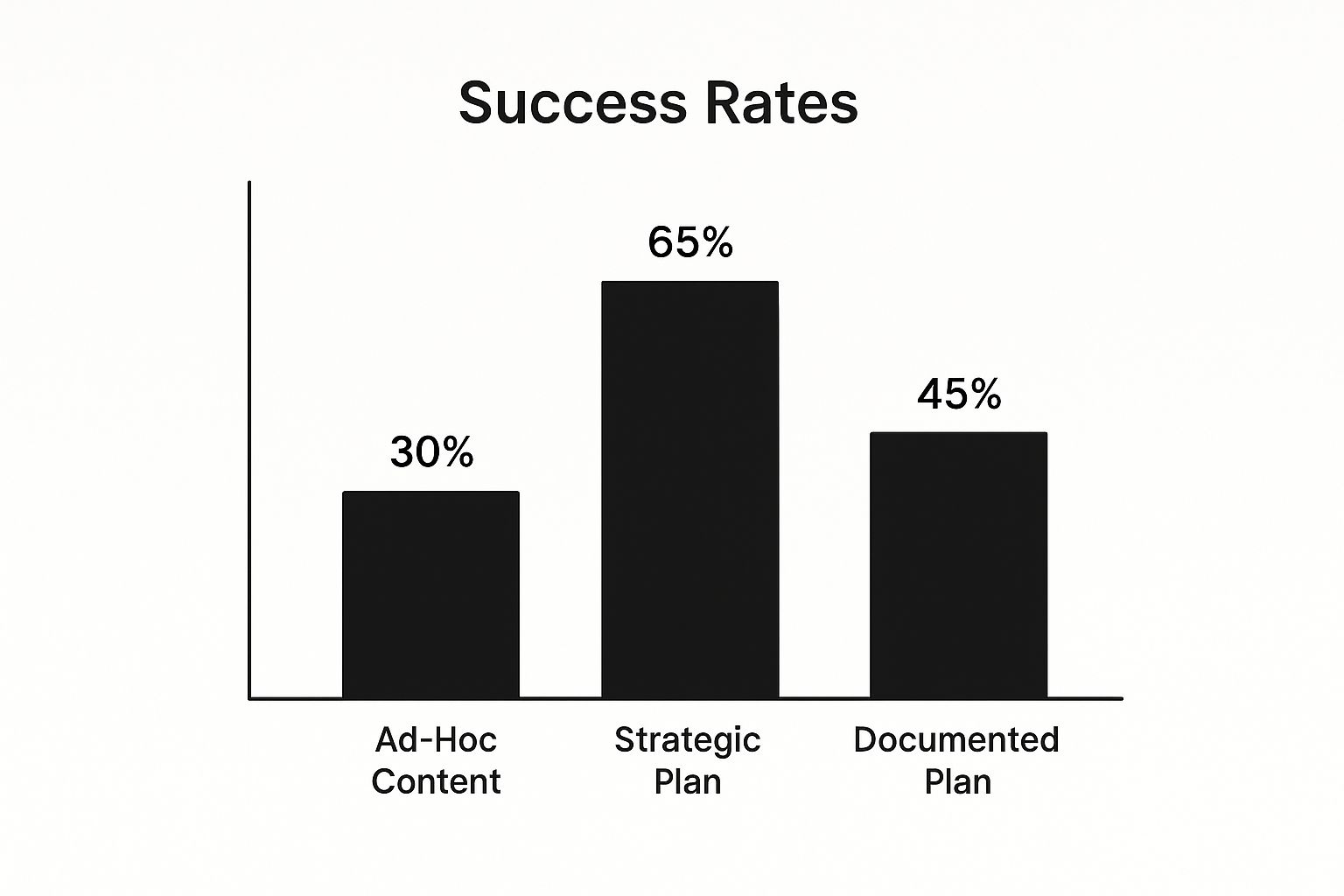A solid content marketing strategy template is more than just a document; it’s a roadmap that guides your team through every single step—from big-picture planning and nitty-gritty creation to smart distribution and honest analysis. It's what turns random acts of content into a powerful, cohesive engine for growing your business.
Think of it this way: a template is the fastest way to ditch the chaos of making content "on the fly" and build a predictable system that actually delivers results.
Why Ad-Hoc Content Fails and Strategy Wins
We've all been there. Jumping straight into creating content without a real plan feels productive. You're churning out blog posts, firing off social media updates, and hitting "send" on emails. But this reactive, ad-hoc approach almost always leads to mixed messaging, wasted time and money, and a frustrating inability to measure what's working.
You're basically driving in the dark without GPS, hoping you'll eventually arrive at your destination.
Adopting a structured template completely changes the game. It forces you to stop just doing content and start strategizing it. Every single asset you create suddenly has a clear purpose, designed to hit a specific business goal and solve a real problem for a well-defined audience.
From Chaos to Clarity
The biggest reason undocumented strategies fail is the lack of clear goals. It’s a huge blind spot. In fact, 42% of marketers point to a lack of clear objectives as the main reason their strategy just doesn't work. Even more telling, only 29% of marketers who do have a documented plan say it's highly effective, which shows just how tough it can be to follow through.
This is where the difference between winging it and planning becomes crystal clear.

The numbers don't lie. Having a documented plan more than doubles your chances of success. A template provides the essential framework to build that winning plan.
To see just how different these two approaches are, let's break it down.
Ad-Hoc Content vs Strategic Content Planning
| Aspect | Ad-Hoc Content (No Template) | Strategic Content (Using a Template) |
|---|---|---|
| Goal Setting | Vague or non-existent; "create more content" | Specific and measurable (e.g., "increase qualified leads by 15% in Q3") |
| Audience Focus | Broad and generic; hopes to appeal to everyone | Highly targeted; based on detailed buyer personas and their pain points |
| Messaging | Inconsistent voice, tone, and value proposition | Cohesive and consistent brand message across all channels |
| Resource Allocation | Inefficient; time and budget are spent on low-impact activities | Optimized; resources are focused on high-priority, goal-driven content |
| Measurement | Difficult to track ROI; relies on vanity metrics like likes or shares | Clear KPIs tied to business objectives; focuses on leads, conversions, and revenue |
| Team Alignment | Siloed efforts; creators, marketers, and sales are disconnected | Unified vision; everyone works from a single source of truth |
The table really highlights the night-and-day difference. One path leads to frustration and wasted effort, while the other paves the way for predictable growth.
Building a Foundation for Success
A template isn't just about filling in boxes. It's about creating a foundational document that gets your entire team on the same page. It becomes the single source of truth for all your marketing efforts.
Here's what it helps you nail down:
- Business Objectives: Defining exactly what success looks like in real numbers (leads, traffic, sign-ups, sales).
- Audience Personas: Getting crystal clear on who you're talking to, what they struggle with, and what they truly care about.
- Core Messaging: Ensuring your brand's voice, personality, and core promises are consistent everywhere.
- Distribution Channels: Picking the right platforms where your audience actually spends their time.
To really escape the ad-hoc trap, a deep respect for the craft is essential. Take some time for understanding content creation to make sure your foundation is rock-solid. By documenting these core pillars, you ensure every piece of content has a purpose from the moment you start brainstorming.
Defining Your Business Objectives and KPIs

Before you even think about brainstorming topics, your content marketing strategy template needs to answer a fundamental question: What are we actually trying to achieve here?
Without a clear destination, you're just creating content for the sake of it, and your efforts will feel scattered and ineffective. The secret to a strategy that actually delivers value is tying every single article, video, and social post back to a real business objective.
This is the shift that turns content from a line-item expense into a revenue-driving investment. It means getting past fuzzy goals like "get more traffic" and drilling down to what success genuinely looks like for your company.
From Vague Ideas to SMART Goals
The best way to do this is by using the SMART framework. It’s a classic for a reason. Making your goals Specific, Measurable, Achievable, Relevant, and Time-bound forces you to add the detail needed to make them real. You're not just hoping for growth; you're setting a precise target.
Let’s look at the difference in practice:
-
Vague Idea: We need more leads.
-
SMART Goal: Generate 50 marketing qualified leads (MQLs) per month from our new ebook by the end of Q3.
-
Vague Idea: We should improve our brand awareness.
-
SMART Goal: Increase organic, non-branded search traffic to our blog by 20% over the next six months.
See how much more powerful the SMART goals are? They’re tangible. They have numbers, deadlines, and a clear path to measurement. This kind of clarity is crucial for keeping your team on track and for proving the ROI of your work to leadership.
Key Takeaway: Every goal in your template must connect to a business outcome. If you can't measure it, you can't manage it, and you certainly can't prove its value.
Aligning Content with Business Priorities
Your content goals shouldn't exist in a silo. To get the resources and support you need, they have to sync up with the company's bigger picture.
For instance, if the entire company is focused on reducing customer churn this quarter, a content goal about customer retention and success stories is going to get a lot more traction than one purely focused on top-of-funnel awareness.
Let's say a company-wide initiative is to start selling to larger, enterprise-level clients. Your content strategy can directly support that by focusing on creating in-depth case studies and white papers that speak to the specific pain points of an enterprise decision-maker. This is a core part of what we cover in our guide on what a content marketing strategy is. Suddenly, content isn't just a marketing function—it's a critical part of the company's growth plan.
When you fill out your template, make sure to spell out both primary and secondary objectives.
- Primary Objective: The main thing you need your content to do (e.g., generate high-quality leads).
- Secondary Objective: The valuable side-effects your content will produce (e.g., build our reputation as an industry expert).
Thinking this way gives your strategy more depth. A single, well-researched industry report can generate leads (primary) while simultaneously positioning your brand as an authority (secondary). By defining these goals from the start, you give every piece of content a clear, multi-layered job to do.
Building Audience Personas That Actually Work

If you try to write for everyone, you end up writing for no one. It's a classic marketing mistake, and the audience persona section of your content marketing strategy template is where you fix it. This is the moment you stop shouting into the void and start having real conversations with the people who matter most.
A well-researched persona turns a fuzzy idea of a "target customer" into someone you can almost picture. It's the difference between guessing and knowing.
Lots of templates I've seen just ask for the basics: age, job title, location. That’s a start, but it’s surface-level stuff. To create content that genuinely connects, you have to get into their heads. What are their biggest fears? What do they hope to achieve in their career? Where are they scrolling online at 10 PM looking for answers?
Beyond the Job Title
Let's get specific. "Marketing Manager" tells you next to nothing. Your goal is to build a character so clear and detailed that you could write a day-in-the-life story about them. This is what separates content that gets scrolled past from content that gets saved and shared.
Here's what I mean:
- Vague Persona: Maria, Marketing Manager
- Detailed Persona: "Maria, the Overwhelmed Marketing Manager at a Mid-Sized Tech Startup who struggles to prove ROI to her skeptical CEO."
See the difference? Now you have a real person with a real problem. Instantly, content ideas pop into your head that solve her specific challenge, like "5 Simple Dashboards That Prove Marketing ROI" or "How to Finally Get C-Suite Buy-In for Your Budget." This is how you stop being just another vendor and start becoming a trusted resource.
Pro Tip: Give your persona a name and find a stock photo to represent them. It feels a little silly at first, but visualizing a real person makes it so much easier to write directly to them. Your tone, language, and messaging will naturally become more authentic.
Crafting Your Persona Profiles
Time to fill out this section of your template. You'll need to gather some intel—a mix of hard data and human insights. Dig into your Google Analytics, talk to your customers, and grab your sales team for 15 minutes to ask about the most common questions and objections they hear. I'd recommend creating two to three core personas that represent the majority of your ideal customers.
For each persona you build, try to answer these questions:
- Goals: What are they trying to accomplish, both at work and in their personal life?
- Challenges: What’s standing in their way? What's the thorn in their side?
- Watering Holes: Which blogs, social media channels, or industry leaders do they follow and trust?
- Motivations: What really drives them? Are they looking for efficiency, growth, or a competitive edge?
The answers you uncover here are the bedrock of your entire strategy. For a deeper dive into this process, check out our complete guide on how to define a buyer persona for your content strategy. Taking the time to do this right ensures every article, video, and social post you create is aimed squarely at solving a real problem for a real person. That’s how you make your content work.
Figuring Out What to Create and Where to Post It

Alright, you've nailed down your goals and have a sharp picture of your audience. Now for the fun part: deciding what you’re actually going to create and where you’ll share it. This is the moment your content marketing strategy template transforms from a document into a real action plan.
The key here isn’t about choosing formats you like to make, but what your audience loves to consume.
I see so many brands get this wrong. They’ll force a format onto an audience that just isn't interested. Think about it: if your research shows your ideal customer is a busy B2B professional, they probably don't have time for a 30-second TikTok dance. They're far more likely to be found on platforms like LinkedIn, where a well-researched white paper or a punchy case study will actually get their attention.
Your choices for content formats and channels have to come directly from the personas you just built. Don’t guess. Use the data you’ve gathered.
Matching Your Content to the Buyer's Journey
As people move from just hearing about you to actually considering a purchase, their needs change. So should your content. Think of it like a conversation—you have to provide the right information at the right time to keep it flowing.
Here’s a practical way to map your content formats to each stage:
-
Awareness Stage (Top of the Funnel): Your mission is to attract and educate. These folks are just starting to realize they have a problem. Good formats for this include blog posts, short-form videos, infographics, and social media updates. For example, a blog post titled "5 Signs Your Current Project Management Tool Is Holding You Back."
-
Consideration Stage (Middle of the Funnel): They're now actively looking for solutions. Your job is to build trust and prove your expertise. This is where case studies, in-depth webinars, white papers, and detailed comparison guides shine. Imagine offering a downloadable case study that shows exactly how a similar company solved their project management headaches with your solution.
-
Decision Stage (Bottom of the Funnel): They're on the verge of buying. Your content needs to give them the final nudge of confidence to choose you. This is the time for free trial offers, live demos, clear pricing pages, and powerful customer testimonials. A personalized demo or a page full of video testimonials from happy customers can be the clincher here.
This journey-based approach ensures you’re not just throwing random content out there. Instead, you're building a system that guides leads from initial curiosity to making a purchase. You can dive deeper into this with our guide on building effective content distribution strategies.
Don't Put All Your Eggs in One Basket
While articles and blog posts are a solid foundation, don't be afraid to mix things up. Weaving different formats into your strategy helps you connect with people on different levels and reach those who prefer to watch or listen rather than read.
Podcasts, for instance, have become an incredibly effective way to build a personal connection. They let you speak directly to your audience, which is perfect for people who consume content while commuting, working out, or multitasking. The numbers back this up: 67% of the U.S. population has listened to a podcast, and 46% of weekly listeners have bought something they heard advertised on a show. It's a fantastic format for building loyalty and driving real action.
Key Takeaway: The "where" is just as important as the "what." A brilliant case study is useless if your audience never sees it. Always prioritize the channels where your ideal customers are already active and engaged.
By carefully mapping out your content formats and distribution channels in your template, you give every single piece of content a clear purpose and the best possible shot at reaching the right person at the perfect moment.
Creating a Sustainable Content Workflow
It’s one thing to have a brilliant strategy on paper, but actually executing it week in and week out without burning out? That’s the real mountain to climb. Your content marketing strategy template absolutely needs a section dedicated to your workflow—the real-world, boots-on-the-ground process of taking an idea and turning it into a published piece of content. This is the operational backbone that turns good intentions into a reliable content engine.
A sustainable workflow isn't about grinding harder; it's about working smarter. It maps out the entire journey of a content piece, from that first spark of an idea through research, creation, editing, approvals, and all the way to promotion. Without this kind of structure, teams often get stuck in a reactive loop, which almost always leads to spotty output and a nosedive in quality.
The truth is, consistency is a huge struggle for most marketers. Getting content to drive real action remains a top challenge, with 55% of B2B marketers admitting they find it difficult. This problem is made worse by the struggle to stand out from the noise (43%) and, frankly, just create content on a regular basis (42%). These are some of the key hurdles marketers expect to face through 2025.
Building Your Content Production Machine
To get ahead of these challenges, you need to build your workflow around efficiency. A great starting point is to organize everything around content pillars. Instead of chasing random topics, zero in on 3-5 core themes that sit at the intersection of your expertise and your audience’s biggest questions. From just one pillar, you can spin off tons of related content ideas, building a cohesive and authoritative voice over time.
Another game-changer is task batching. Rather than tackling one blog post from start to finish before moving on, try dedicating blocks of time to specific stages of the process.
It might look something like this:
- Monday morning: Outline four blog posts.
- Tuesday: Do all the keyword research for those four outlines.
- Wednesday: Hammer out the first drafts.
This approach cuts down on the mental drain of constantly switching gears and can give your productivity a serious boost. To really supercharge your production, it's worth exploring the best AI tools for content creators. These tools can help with research, drafting, and even SEO, slotting perfectly into a batched workflow.
A documented workflow transforms content creation from a chaotic art into a repeatable science. It builds a predictable system that keeps quality and consistency high, even on days when you're not feeling particularly inspired.
Maintaining Quality and Consistency
Finally, a simple style guide is your best friend. This doesn't need to be a 50-page manifesto. It just needs to cover the basics to keep your brand voice consistent, which is especially critical if you're working with freelancers or bringing new people onto the team.
Just make sure to include these essentials:
- Tone of Voice: Are you authoritative and serious? Friendly and conversational? Witty and a little edgy?
- Formatting Rules: Lay out how you use headings, bold text, and bullet points.
- Brand-Specific Language: Are there certain terms you always use? Any words you want to avoid?
By mapping out these operational details right inside your content marketing strategy template, you’re building a much more resilient process. This system doesn't just guarantee a steady stream of great content; it also protects your team from the inevitable burnout that comes from a disorganized, "make it up as you go" approach.
Got Questions? Let's Talk Strategy
Even with a killer template, you're going to have questions. It's totally normal. Think of your content marketing strategy template less like a stone tablet and more like a living playbook for your team.
Getting these details right is what turns a plan on paper into a content engine that actually drives results. Let's tackle some of the most common hurdles I've seen pop up when teams start putting a new strategy into play.
Sometimes you just need a quick answer. I've put together this table to give you fast clarity on the most common questions about putting your strategy template into action.
Quick Answers to Your Strategy Template Questions
| Question | Answer |
|---|---|
| How often do I need to update this thing? | Plan for a major review every six months. For a quicker pulse check, review your core metrics monthly and do a deeper tactical dive quarterly. |
| What happens if we fall behind schedule? | Don't panic. Prioritize the most critical content, lean on your existing evergreen posts to fill gaps, and then adjust the calendar realistically. |
| How do I get my team to actually use the strategy? | Involve them in creating it. When they see their ideas in the final document, they'll feel a sense of ownership. Also, make it a core part of your team meetings. |
| What’s the single biggest mistake to avoid? | Letting the strategy collect digital dust. A strategy is useless if it isn't actively used to guide decisions on a weekly and even daily basis. |
These quick hits cover the basics, but let's explore some of the nuance behind them. Getting this right is crucial for long-term success.
How Often Should I Really Update My Content Strategy?
This is a big one, and the answer is definitely not "once a year." Your content strategy has to be agile enough to keep up with your business. I've found the sweet spot is a major review and refresh every six months. This cadence is frequent enough to react to market shifts or new competitor tactics without constantly derailing your team's focus.
But that's just the big picture. You need to be checking in on your progress much more often.
- Monthly Check-ins: This is your quick pulse check. Look at your core KPIs. Is traffic trending up? Are you hitting your lead goals? This is where you spot small issues before they snowball.
- Quarterly Reviews: Time to go a bit deeper. Dig into which content pillars are really resonating and which ones are falling flat. Is a particular social channel a ghost town? Now's the time to make tactical pivots, like shifting budget or trying a new format.
Think of it this way: your six-month review is for looking at the map to confirm you're still heading to the right destination. Your monthly and quarterly check-ins are the small steering adjustments you make along the way.
A static strategy is a failing strategy. Regular, scheduled reviews ensure your content remains relevant and effective, preventing you from wasting resources on tactics that just aren't working anymore.
What if We Fall Behind on the Content Calendar?
It happens. I’ve yet to meet a content team that hasn't fallen behind at some point. A key project gets bogged down, someone gets sick, or a piece of content just ends up being way more complex than you anticipated.
The absolute worst thing you can do is panic and start shoving out half-baked content just to fill a slot on the calendar. That's a fast track to eroding audience trust.
Instead, your template should have a built-in contingency plan. Here’s a simple framework that works:
- Prioritize Ruthlessly: Look at your upcoming schedule. What’s the one piece you absolutely cannot delay? The one with the biggest business impact? Pour your energy into that.
- Lean on Your Evergreen Content: This is your secret weapon. Re-share a top-performing blog post from last year on social media. Turn a popular webinar into a series of short video clips. Your audience hasn't seen everything you've ever created, I promise.
- Adjust and Communicate: This is key. Update the calendar with a realistic new timeline and let the team know what’s happening. Transparency about a small delay is infinitely better than creating a culture of burnout by chasing an impossible deadline.
Falling behind isn't a failure; it's a signal to reassess your team's capacity and workflow.
How Do I Get My Team to Buy Into This New Strategy?
Honestly, getting your team to consistently use the template can be a bigger challenge than building it in the first place. The secret isn't a fancy launch presentation; it's involvement.
Don't just hand down a finished document from on high and expect everyone to salute.
Instead, bring them into the process early. Ask them for their input during the audience persona brainstorming. Get their ideas for the main content pillars. When people see their own insights reflected in the final strategy, they immediately have a sense of ownership. They helped build it, so they're more invested in seeing it succeed.
Then, make the strategy a living part of your team's rhythm. Don't let it become a file that just sits in a folder. Start every content meeting by quickly reviewing your strategic goals and KPIs. When the template is the foundation for every decision you make together, it becomes second nature.
Ready to stop guessing and start building a predictable content engine? With EvergreenFeed, you can automate your social media scheduling, ensuring your best content consistently reaches your audience without the manual grind. Sign up for free and see how easy it is to put your content strategy on autopilot.




